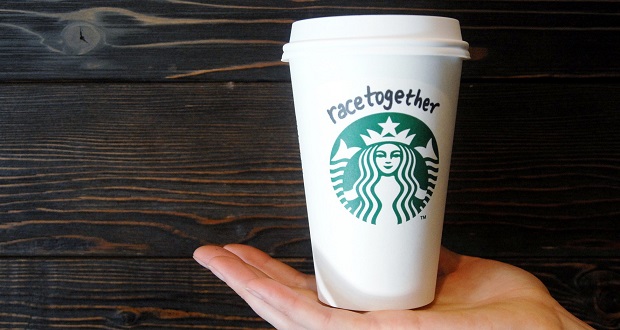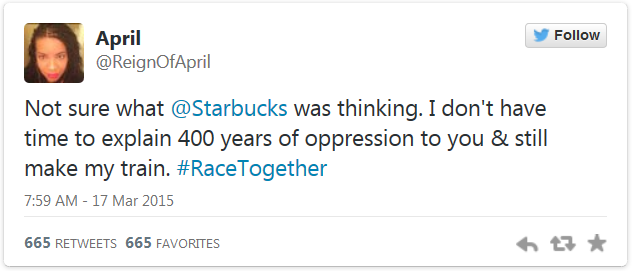
The unfolding of events with the well intentioned Starbucks “Race Together” campaign provide an important lesson about where we are with race relations in America. Many activists for racial equality have been calling for more authentic dialogue on the topic for years…100’s of years as a matter of fact. Recognizing that we remain polarized in our attitudes about the extent to which we believe race plays a key role in the outcomes for blacks, CEO Howard Schultz took a bold move and said let’s start a national dialogue.
There is widespread consensus among pundits that the campaign was a failure. After a week of asking baristas to write “race together” on coffee cups as a way of stimulating dialogue in Starbucks retail outlets, that part of the initiative seemed to be abruptly stopped. Schultz says that it was not because of the overwhelming negative response to the campaign. He claims it the cup writing part of the initiative was only meant to last for a week.
“While there has been criticism of the initiative – and I know this hasn’t been easy for any of you – let me assure you that we didn’t expect universal praise. The heart of Race Together has always been about humanity: the promise of the American Dream should be available to every person in this country, not just a select few. We leaned in because we believed that starting this dialogue is what matters most. We are learning a lot. And will always aim high in our efforts to make a difference on the issues that matter most.” Howard Schultz, Starbucks CEO
I applaud Schultz for taking such a bold move. We can say that we learned a lot in just a short period of time. We learned that people of color rejected the campaign because they realized that you cannot have an authentic dialogue on race over a cup of coffee.
Tweets like this emerged.

Starbucks Vice President of Communications felt compelled to shut down his Twitter account due to so many negative comments about the campaign from different racial groups.
“Last night, around midnight, I deleted my Twitter account. I also blocked a handful of Twitter users — given the hostile nature of what I was seeing, it felt like the right thing to do. I’ve been a dedicated — some might say obsessive — Twitter user for nearly seven years and as a professional communicator, Twitter has proven to be a valuable tool for me to interact with my professional community, with media, on behalf of Starbucks, as well as “on behalf of me.” But last night I felt personally attacked in a cascade of negativity. I got overwhelmed by the volume and tenor of the discussion, and I reacted. Most of all, I was concerned about becoming a distraction from the respectful conversation around Race Together that we have been trying to create.”
In January, The Winters Group hosted the first in our “Let’s Talk About It Series” on the topic of why race is such a difficult discussion. We had about 100 people join the virtual session. They offered the following reasons why race is so difficult to discuss:
- Fear of being labeled a racist if you say the wrong thing
- Race weary (Tired of talking about a subject that seems to go no where)
- Guilt and shame
- Not sure how to start a conversation on race (“I don’t know what to say”)
- Afraid of being offensive or being offended
- Lack of skill to know how to have a meaningful discussion
From my perspective the key issue which some of the critics of the Starbucks campaign brought out, is that we don’t know how to have the discussion. There is an assumption that you can start to talk about race just as easily as you can talk about the weather.
During the Let’s Talk About Race session we offered tips on how to have a one-one conversation as well as a team discussion about race.
[dropshadowbox align=”none” effect=”lifted-both” width=”600px” height=”” background_color=”#ffffff” border_width=”1″ border_color=”#dddddd” ]
Developmental Dialogue Process™
Team Readiness Assessment
1. How much trust do we have within the team?
- Conduct an independent anonymous survey
- Proceed depending on the level of trust
- Low trust-before commencing dialogue about race, build trust
2. What is the common ground?
- Focus on those elements where there is common agreement
- Before moving forward allow enough time for reflection
3. What facts can you bring to the table about differences that are credible and undisputable?
- Have a cross-cultural team collect the facts to reduce the perception of bias
4. What is our skill level to have authentic dialogue?
- How culturally competent is the team? (knowledge, skills)
- Do we understand our own biases?
- Is the team capable of empathy? Non-judgmental evaluation?
- Is our team OK with being in a place of discomfort? Non-closure?
- Can we accept different levels of emotion and engagement?
- Will we allow enough time for individual and group reflection?
- How did that feel for you?
5. How will we continue the dialogue?
- What is our process for addressing situations that arise in-between sessions?
- Develop cross-cultural learning partners model
[/dropshadowbox]
[dropshadowbox align=”none” effect=”lifted-both” width=”600px” height=”” background_color=”#ffffff” border_width=”1″ border_color=”#dddddd” ]
Using the Developmental Dialogue Process™
to Start One-One Dialogue
Step 1: Probe for desire
- I don’t claim to understand how the recent events may be impacting you. Is it something you would like to talk about? I am open and would like to learn more from your perspective.
- If no desire, then leave the door open to discuss at another time
Step 2: If desire exists, seek common ground
- Remain neutral and non-judgmental
- Know the “facts” as they have been presented from all sides
- Goal is to build trust and reach common ground during first discussion
- May need to keep your opinion out of the first discussion
Step 3: Decide how far to take the first conversation
- Listen to each other
- Seek first to understand
- Be tolerant of mistakes, misinformation from your perspective
- Affirm perspectives on the facts
- Do not debate
- Be OK with non-closure
Step 4: Agree to meet again after time to reflect
- In the interim, gather more facts
- Seek out other opinions and perspectives
- Check your own biases and beliefs
Step 5: Meet again and again as desired (Cross Cultural Learning Partners)
- Begin to share differences
- Remain non-judgmental
- Try to see the situation from the other person’s perspective
- Be OK if conclusion is agree to disagree
[/dropshadowbox]
What is the Inclusion Solution?
The Inclusion Solution is to first develop the skills necessary to have authentic dialogue. It is not a topic that one can just dive into over coffee without some significant training and reflection. We have to structure these conversations with skilled facilitators and allow enough time to process. It is hard work and ongoing work. I trust that Starbucks will not give up. We desperately need real, authentic dialogue around race once and for all. Dialogue that does not continue to divide but brings us together, understanding that there are differences that make a difference in our life’s experiences and race is one of those differences.

















